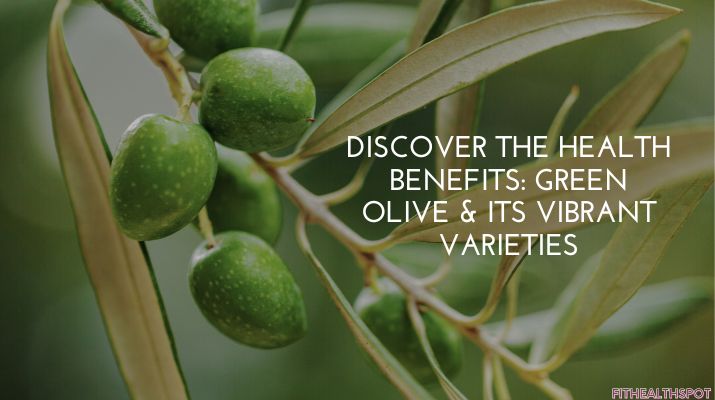The Wonderful World of Olives: An Introduction
Green olives and their vibrant counterparts have carved a unique niche in the vast world of gastronomy. These small, stone-bearing fruits, cultivated for over 6,000 years, encapsulate a blend of history, culture, and culinary versatility. Originating from the Mediterranean region, olives, especially the popular green olives, have become a global phenomenon, featuring prominently in diets and cuisines from Europe to Asia.
What do olives taste like?
Describing the taste of olives can be as intricate as deciphering the notes in a vintage wine. They offer a distinctive combination of saltiness, bitterness, and a touch of umami, making them an irreplaceable addition to various dishes. Whether it’s the subtle butteriness of some or the pronounced briny kick of others, each type of olive offers a unique flavor experience. Like the nuanced flavors found in green tea shots, olives have layers of taste waiting to be explored.
Their exceptional taste, combined with myriad health benefits, positions olives not just as a culinary delight but also a nutritional powerhouse. This guide will take you through the diverse world of olives, highlighting their types, benefits, and culinary applications.
Exploring Olive Varieties and Their Health Benefits: A Comprehensive Guide
Dive deep into the world of olives, and you’ll discover an array of varieties, each with unique flavors and health benefits. Let’s explore three of these varieties in detail:
Green Olives: The Universal Favorite
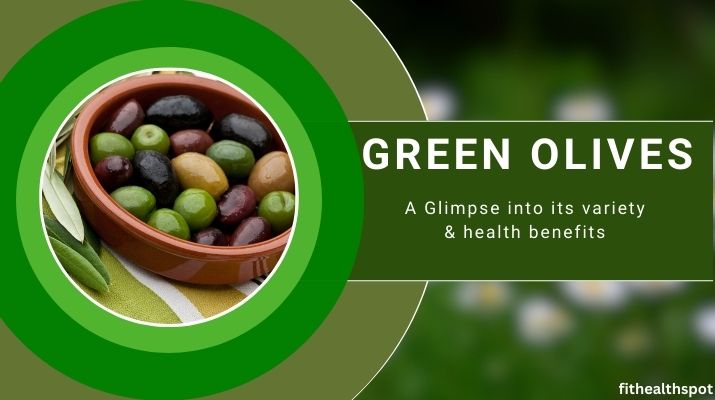
Renowned for their bright hue and slightly bitter taste, green olives are often harvested before they ripen. Their versatility makes them a staple in many dishes worldwide.
Health Benefits:
- Nutritional Powerhouse: Green olives contain vital nutrients such as vitamin E, iron, copper, and calcium.
- Heart-Healthy Fats: These olives provide a rich supply of monounsaturated fats, known to decrease the likelihood of heart ailments. For a deeper dive into foods that benefit heart health, explore the health benefits of cavatappi pasta.
Kalamata Olives: A Taste of Greek Culinary Art

Originating from the city of Kalamata in Greece, these dark purple, almond-shaped olives are a beloved ingredient in Greek salads.
Health Benefits:
- Rich in Essential Nutrients: Kalamata olives are a storehouse of vital nutrients that promote overall health.
- Improved Heart Health: Their consumption can enhance cholesterol levels and decrease inflammation, similar to the health properties found in smoked salmon.
Castelvetrano Olives: Italy’s Prized Jewel
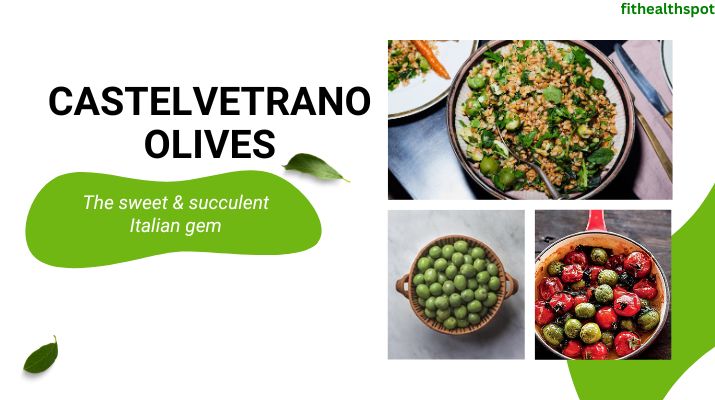
Hailing from Sicily, Castelvetrano olives are cherished for their sweet, mild flavor and smooth, buttery texture.
Health Benefits:
- Antioxidant Boost: These olives are teeming with antioxidants that combat free radicals, safeguarding against cellular damage. For another antioxidant-rich food, consider incorporating buckwheat flour into your diet.
Stuffed Olives: A Culinary Delight Meets Wellness

Stuffed olives are a testament to culinary creativity. Combining the natural richness of olives with various fillings transforms them into a moreish delight that’s not just tantalizing to the taste buds but also loaded with health benefits.
Blue Cheese Stuffed Olives: The Gourmet’s Choice

These olives are where luxury meets nutrition. The sharp and tangy flavor of blue cheese paired with the meaty texture of olives creates a taste sensation that’s hard to resist.
Health Benefits:
- Calcium Galore: Blue cheese offers a significant amount of calcium, crucial for maintaining robust bones and teeth.
Beneficial Bacteria: Blue cheese is fermented and contains probiotics, which are good for gut health. For more on foods that support digestion, discover the advantages of oat bran.
Garlic Stuffed Olives: A Burst of Aroma and Health

Stuffed with aromatic garlic, these olives are a treat to both the olfactory senses and the palate. Beyond the flavor, they pack a punch when it comes to health.
Health Benefits:
- Immunity Boost: Garlic is known for its antimicrobial properties, strengthening the body’s defense against pathogens.
- Heart-Friendly: Both garlic and olives have heart-protective benefits, ensuring better circulation and cholesterol levels. If heart health interests you, you might want to explore non-surgical weight loss procedures as a way to reduce cardiac risks.
Choosing Olives for Drinks and Dishes
The type of olive you select can make a difference in culinary arts and mixology. While some varieties lend themselves to specific dishes, others are ideal for cocktails.
Selecting the Best Olives for a Martini: Elevate Your Cocktail Game
Martini enthusiasts often debate the best olive choice, which concerns personal preference. Historically, green olives, especially the pimento-stuffed variety, have been the go-to. However, Kalamata or Castelvetrano olives can be a great option for those who prefer a smoother, richer taste.
Nutritional Gains from Martini Olives:

- Hydration: Olives can replenish sodium levels, making your martini not just flavorful but also a tad hydrating.
- Rich in Good Fats: Olives are a source of monounsaturated fats, promoting heart health. To further enhance your diet with heart-healthy options, consider adding smoked salmon to your menu.
Demystifying Olives: Tackling Common Questions
Olives, in all their culinary splendor, also come with many questions. Let’s unravel some of the mysteries surrounding this Mediterranean marvel.
Are Olives a Vegetable or Fruit?
This is a question that has puzzled many. Botanically speaking, olives are fruits. They develop from the flower’s ovary and contain seeds. Culinary practices, however, often classify them as vegetables due to their savory taste profile.
How Many Olives Should I Eat a Day?
Like any food, moderation is key. While olives are packed with nutrients, they’re also high in sodium, especially when preserved. A serving of 5-7 olives is generally acceptable for most individuals. However, for those monitoring their salt intake, consulting with a healthcare provider is essential. If you’re considering making any significant dietary changes, our guide on intermittent and dry fasting is worth exploring to understand other dietary strategies.
Dietary Aspects of Olives
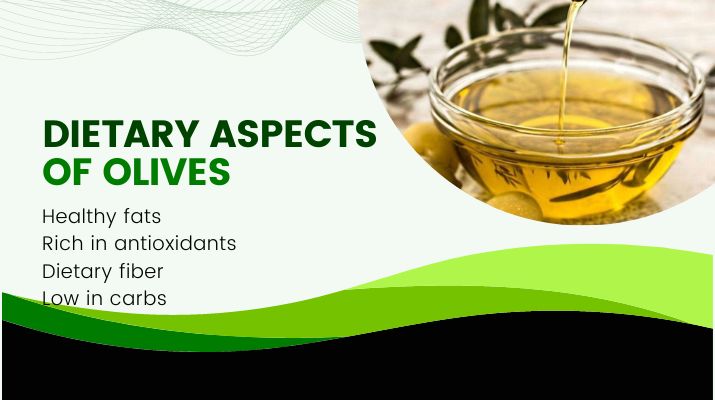
The versatility of olives stretches beyond their flavor. Their dietary implications are essential, especially in today’s health-conscious world.
Are Olives Keto-Friendly? Delving into the World of Low-Carb Diets
The ketogenic diet, commonly called ‘keto,’ is a low-carbohydrate, high-fat dietary regimen. Given olives’ relatively low carbohydrate content and rich fat profile, they fit seamlessly into a keto diet. Consuming olives can help those on keto stay satiated and receive a dose of beneficial fats.
Is Eating Too Many Olives Bad for You? Striving for a Healthy Balance
Everything in excess has its downsides. While olives boast numerous health benefits, they are also rich in sodium, especially when brined. Overconsuming can lead to elevated blood pressure and other related health issues. It’s essential to strike a balance and be mindful of portion sizes. Our post on non-surgical weight loss procedures offers valuable insights for a comprehensive understanding of managing diet and its implications.
Proper Olive Care and Preparation
Maintaining the freshness and quality of olives is vital, especially if you’re keen on savoring their natural goodness.
Do Olives Go Bad? Navigating the Shelf Life of this Mediterranean Delight
Like all perishables, olives, too, have an expiration. Once opened, a jar of olives should be refrigerated and ideally consumed within a couple of weeks. However, if they start exhibiting an off smell, change in texture, or mold, it’s time to discard them.
How to Pit Olives Efficiently: A Handy DIY Guide
Pitting olives can be a bit tricky, but with the right technique, it becomes a breeze:
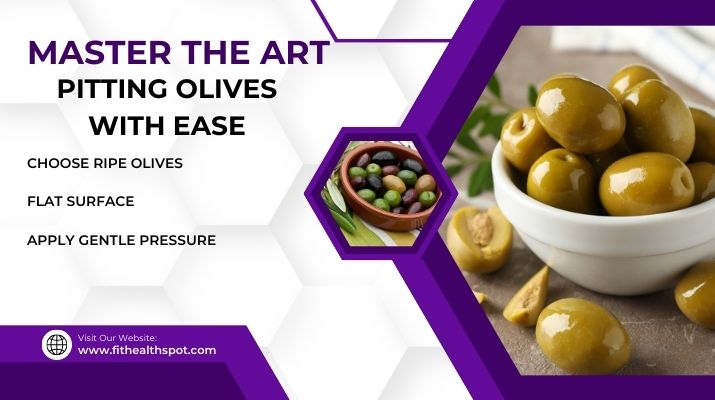
1. Place the olive on a chopping board.
2. Using the flat side of a knife, press down gently on the olive until it slightly squashes.
3. This will loosen the pit, making it easier to remove.
4. Using your fingers or the knife, extract the pit.
Investing in an olive pitter can be a time-saver for those who regularly incorporate olives into their dishes. And while preparing foods efficiently, discover the myriad ways to use buckwheat flour in your culinary adventures.
Conclusion: Embracing the Richness and Wellness of Olives
Olives, whether enjoyed fresh, brined, or stuffed, are a testament to nature’s bounty. They’re not just culinary delights but also repositories of health and wellness. From their role in heart health to their dietary versatility in low-carb diets, olives are all-rounders in nutrition.
In this age where health is paramount, it’s heartening to know that some of our favorite flavors also come packed with numerous benefits. By understanding the variety, care, and dietary implications of olives, we can better incorporate them into our diets, ensuring that we not only savor their unique taste but also reap their health advantages.
As we wrap up our journey through the olive orchards, it’s clear that these tiny fruits (or vegetables, depending on your viewpoint!) have so much to offer. And as with all foods, balance and moderation are key. So, the next time you reach for that olive jar or order a dish with olives, remember the rich tapestry of history, culture, and wellness they represent. It’s a reminder that sometimes, the best things come in small packages.
Frequently Asked Questions (FAQs) about Olives
Where do olives grow?
Olives primarily grow in the Mediterranean region but are also cultivated in parts of California, South America, and other areas with a similar climate.
What do olives taste like?
Depending on their preparation and variety, olives have a unique savory flavor, often described as salty, briny, or tangy.
Can you eat raw olives?
Raw olives are typically bitter. They are usually cured or processed to remove the bitterness, making them palatable.
How long do olives last after opening?
Once opened, a jar of olives should be refrigerated and ideally consumed within a couple of weeks, although they can last longer if kept in their brine.
Are olives good for weight loss?
Olives are low in calories and rich in healthy fats. While they can be a part of a weight loss diet, moderation is key due to their sodium content.

